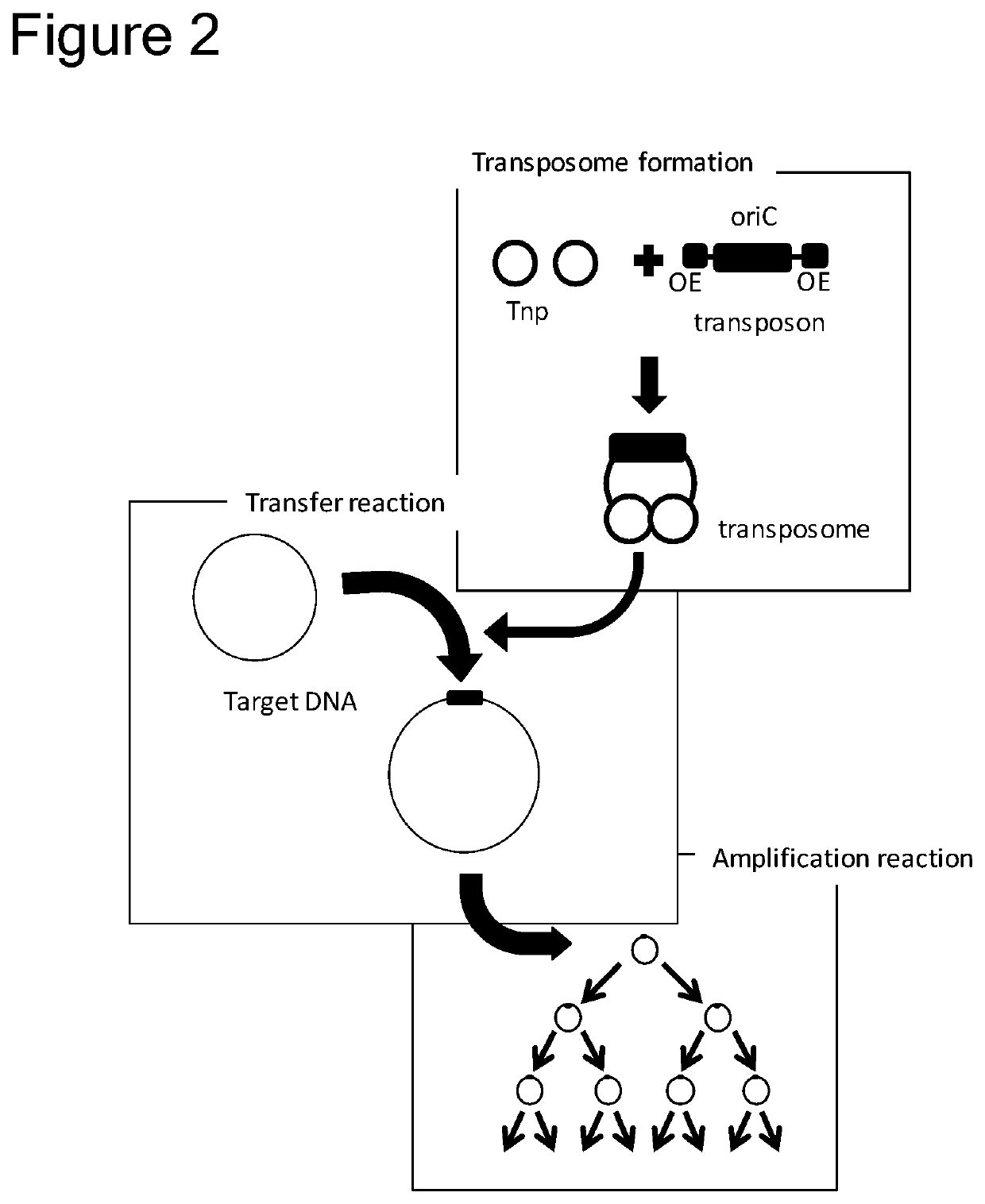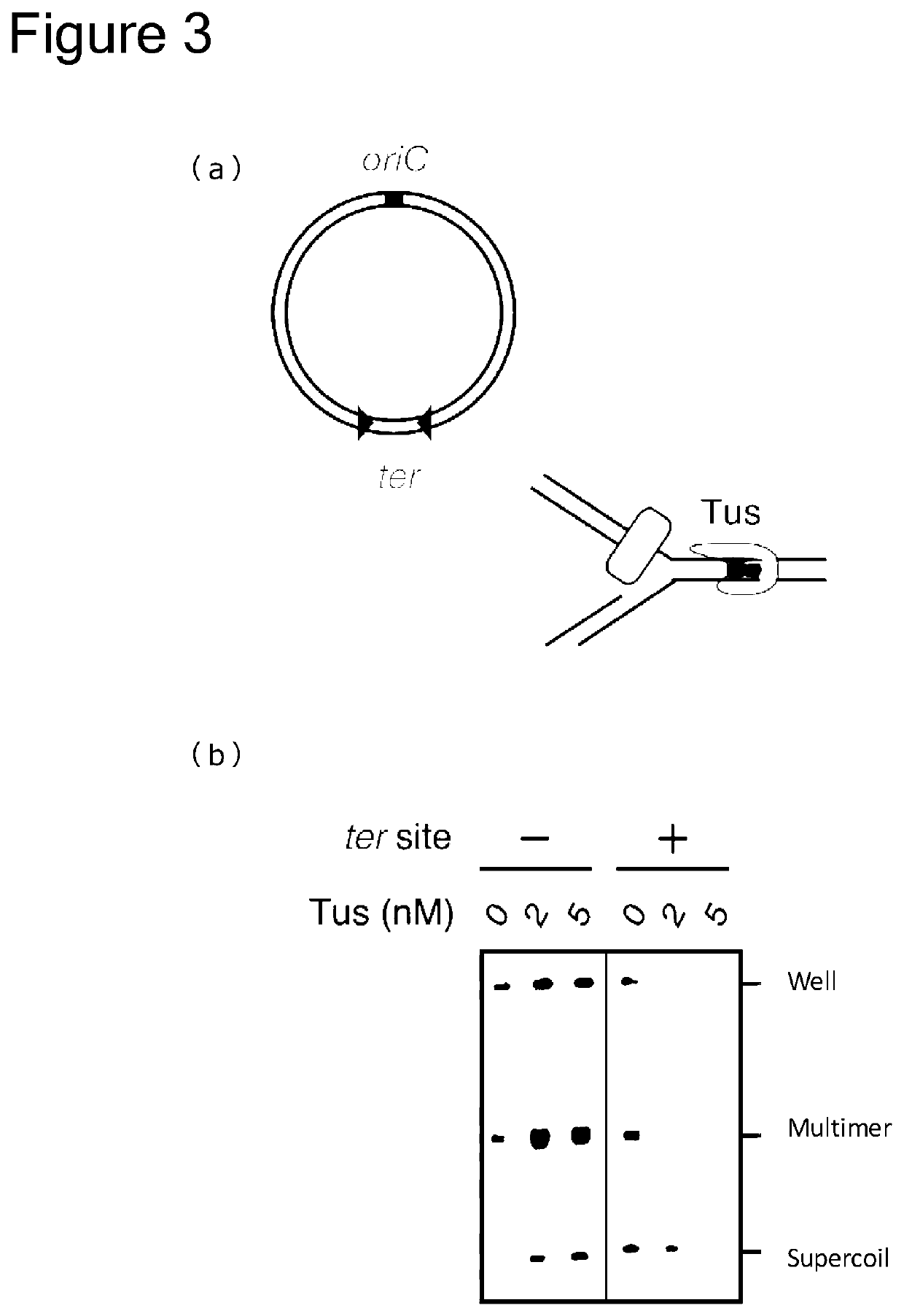Method of replicating or amplifying circular DNA
a dna replicating and dna technology, applied in the field of replicating or amplifying circular dna, can solve the problems of limited environment for experimenting such dna cloning, limited dna size that can be amplified to within a few kbp, and inability to use pcr to amplification in vitro
- Summary
- Abstract
- Description
- Claims
- Application Information
AI Technical Summary
Benefits of technology
Problems solved by technology
Method used
Image
Examples
example 1
on of Circular DNA Associated with Suppression of DNA Multimer by Utilizing Termination Sequence Ter and Tus Protein
[0257]
[0258]Circular DNA to be used as a template was prepared as follows. An oriC fragment was inserted into an M13mp18 plasmid vector to produce 8.0-kb circular DNA. Into a region opposite to oriC in this 8.0-kb circular DNA, a DNA fragment comprising two ter sequences (underlined) facing to each other
(5′-ACTTTAGTTACAACATACTTATT-N176-AATAAGTATGTTGTAACTAAAGT-3′ (SEQ ID NO: 26))
was inserted, to produce ter-inserted 8.0-kb circular DNA (FIG. 3(a)). This ter-inserted 8.0-kb circular DNA was used as template DNA, and the aforementioned 8.0-kb circular DNA was used as control DNA that did not comprise a ter sequence.
[0259]Tus was prepared by generating it from a Tus-expressing Escherichia coli strain according to a step comprising affinity column chromatography and gel filtration column chromatography.
[0260]A reaction solution having the composition shown in Table 1, and a...
example 2
on of Circular DNA Associated with Suppression of DNA Multimer by Utilizing Site-Specific Recombination Sequences Dif and XerCD
[0278]
[0279]dif-inserted 12-kb circular DNA to be used as a template was prepared by performing a recombination reaction in Escherichia coli cells so that the dif sequence (SEQ ID NO: 22) was comprised in a region opposite to the oriC of the circular DNA (FIG. 4(a)). Specifically, using Escherichia coli expressing a recombination protein group of X phage, an intracellular recombination reaction was carried out to prepare circular DNA with a desired length including a cassette comprising oriC and a kanamycin resistance gene, and a 4.2 kb region upstream and a 6.0 kb region downstream of dif in the Escherichia coli chromosome.
[0280]As control DNA not comprising a dif sequence, the 8.0-kb circular DNA described in Example 1 was used.
[0281]XerCD was prepared by purifying it from a XerC and XerD co-expressing Escherichia coli strain according to a step comprising...
example 3
of Position of Ter Sequence or Dif Sequence in Circular DNA
[0287]In Examples 1 and 2, template DNA was prepared such that the ter sequence or the dif sequence was positioned in a region opposite to oriC in the circular DNA. In Example 3, a replication and / or amplification reaction was carried out on circular DNA, in which the ter sequence or the dif sequence was disposed in a position close to or adjacent to oriC.
[0288]
[0289]In order to construct 15-kb circular DNA, using Escherichia coli genome as a template, a 15-kb DNA fragment not comprising oriC was amplified and prepared.
[0290]As circular DNA in which the ter sequences were disposed close to oriC, 15 kb ori-ter circular DNA was prepared as follows. An ori-ter cassette was connected with the above described 15-kb DNA fragment, followed by circularization, to produce the ori-ter circular DNA (FIG. 5). The sequence of the ori-ter cassette (0.38 kb) was as follows, and the ter sequences facing outward (underlined portions) were pr...
PUM
| Property | Measurement | Unit |
|---|---|---|
| concentration | aaaaa | aaaaa |
| concentration | aaaaa | aaaaa |
| concentration | aaaaa | aaaaa |
Abstract
Description
Claims
Application Information
 Login to View More
Login to View More - R&D
- Intellectual Property
- Life Sciences
- Materials
- Tech Scout
- Unparalleled Data Quality
- Higher Quality Content
- 60% Fewer Hallucinations
Browse by: Latest US Patents, China's latest patents, Technical Efficacy Thesaurus, Application Domain, Technology Topic, Popular Technical Reports.
© 2025 PatSnap. All rights reserved.Legal|Privacy policy|Modern Slavery Act Transparency Statement|Sitemap|About US| Contact US: help@patsnap.com



